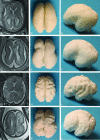Demonstration of Normal and Abnormal Fetal Brains Using 3D Printing from In Utero MR Imaging Data
- PMID: 27079366
- PMCID: PMC7984678
- DOI: 10.3174/ajnr.A4783
Demonstration of Normal and Abnormal Fetal Brains Using 3D Printing from In Utero MR Imaging Data
Abstract
3D printing is a new manufacturing technology that produces high-fidelity models of complex structures from 3D computer-aided design data. Radiology has been particularly quick to embrace the new technology because of the wide access to 3D datasets. Models have been used extensively to assist orthopedic, neurosurgical, and maxillofacial surgical planning. In this report, we describe methods used for 3D printing of the fetal brain by using data from in utero MR imaging.
© 2016 by American Journal of Neuroradiology.
Figures




References
-
- Griffiths PD, Morris J, Larroche JC, et al. . Atlas of Fetal and Postnatal Brain MR. Philadelphia: Mosby/Elsevier; 2010
-
- Bayer SA, Altman J. The Human Brain during the Third Trimester. Boca Raton, Florida: CRC Press; 2004
-
- Eggbeer D, Bibb R, Paterson AM. Medical Modelling: The Application of Advanced Design and Rapid Prototyping Techniques in Medicine: Second Edition. Cambridge: Elsevier Imprint: Woodhead Publishing Series in Biomaterials; 2015
MeSH terms
LinkOut - more resources
Full Text Sources
Other Literature Sources
Medical
